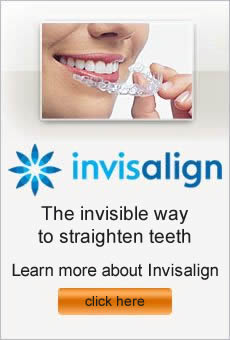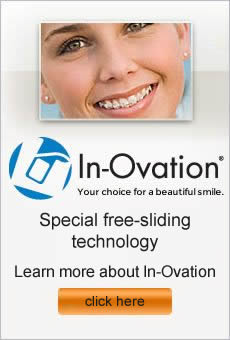Braces are extremely sturdy and durable, but they are still capable of being popped off, dislodged or damaged if the patient eats the wrong thing. As a rule of thumb, avoid any food that is overly chewy, sticky or hard. Here is a list of foods that aren’t recommended while wearing braces:
- nuts
- popcorn
- tortilla chips
- sticky or hard candy, especially taffy and caramel or anything “gummy”
- ice
- chewing gum
- beef jerky
- hard cookies, crackers or wafers
- corn on the cob
Some foods are okay to eat, but will need to be eaten carefully. Biting into foods with your front teeth can seriously damage your brackets, and biting into something and then making a “tearing” motion can also damage your braces. The following foods should be consumed carefully when wearing braces:
- thick bread, such as French or Italian bread
- bagels or hard rolls
- raw vegetables like celery or carrots
- raw fruits like apples, pears or plums
- meat such as steak or pork loin
- ribs
- pizza crust
- pickles
Some foods are approved completely for consumption, such as:
- bananas
- yogurt
- hull-less popcorn
- cheese
- grapes
- melons
- mashed potatoes
- pasta
- peanut butter and jelly
In addition to being aware of the foods you’re eating, be aware of your personal habits. Do you bite your nails? With braces, you will want to stop. Chewing pens and pencils is also a habit you’ll have to break, or you’ll risk damage to your braces.
Speak to Burbank CA orthodontist Dr. Fotovat if you have any questions about what foods or activities you should eschew while wearing braces. In no time at all, you’ll be enjoying life after braces, eating what you like with your straight, aligned teeth. Until then, treat your braces with care!
If you or your child have been referred by your dentist to an orthodontist for treatment to straighten teeth, there are some questions you will want to ask to ensure a successful experience. Orthodontic treatment is an extensive process, so arming yourself with knowledge will help guarantee optimal results. When consulting with an orthodontist, consider asking the following:
- What type of braces do you recommend? Would Invisalign, lingual, or Speed braces be an option?
- Will braces be necessary for the top teeth, bottom teeth, or both?
- Will rubber bands be necessary to correct the bite?
- Will headgear or other appliances be necessary? If so, for how long and when will the appliance need to be worn?
- Will any teeth need extraction?
- Will orthodontic treatment alter the facial appearance?
- What is the schedule for orthodontic checkups and adjustments over the course of treatment?
- What happens if a wire or bracket breaks or is poking into the cheek or gums? Will this require a visit to the orthodontic office?
- Do braces hurt? If so, for how long and how should the discomfort be controlled?
- Is it possible to play contact sports when wearing braces?
- What kind of oral home care will be necessary with braces? Do braces require special brushes, toothpaste, or floss to maintain?
- How long will orthodontic treatment take from start to finish?
- Will a retainer be necessary after treatment is finished? If so, what kind of retainer will you provide and when will it be worn?
Today’s orthodontics offers many options for straightening teeth and correcting jaw problems. It is vitally important that you are comfortable with the process before beginning treatment. In cooperation with a qualified orthodontist, your treatment will result in a lifetime of straighter, healthier smiles. Schedule your consultation with Sherman Oaks orthodontist, Dr. Fotovat.
Studies have shown that today’s teens are under more pressure than ever, from society, from their peers and from themselves. Some of the most awkward times in a person’s life can be during puberty, between the ages of 11 and 14. It’s during this time that so many teens are getting braces.
Most orthodontists wait to begin orthodontia until a patient’s adult teeth have fully descended. This corresponds with puberty in most young people. When braces are applied at this stage, the bones of the mouth are still forming and tooth alignment issues can be corrected far more quickly than they can be corrected in adults. Unfortunately, adding the aesthetic burden of metal braces can lead many teens to feel unhappy and dissatisfied regarding their appearance.
Invisalign aligners directly address these aesthetic issues by providing teeth straightening via a series of clear plastic trays, or aligners. These aligners stay in place most of the day and straighten a teen’s teeth in stages. When one tray’s work is done, another tray takes its place.
If a teen’s adult teeth have not fully erupted, Invisalign aligners can have eruption tabs to accommodate incoming teeth. With such design features as power ridges, Invisalign can provide the high level of force needed to move even the largest tooth and its roots.
Aligners allow your teen to remove the trays while eating and brushing, keeping his or her mouth healthier. Trays must be worn as recommended, however, in order to achieve best results. Invisalign should be in the mouth a minimum of twenty-two hours a day, so your teen must be responsible and dedicated.
Ask Sherman Oaks Invisalign orthodontist Dr. Fotovat if your teen is a candidate for Invisalign. Your teen may be able to have straighter teeth without the embarrassment of being a “brace face.”
Let’s face it. When you talk about straightening teeth, images of middle school kids with mouths full of metal and colored bands come into your mind. As an adult, those images might give you nightmares if you imagine it for yourself. But what if you have crooked teeth or problematic bite issues? What are your teeth-straightening choices that won’t embarrass you? Invisalign is the answer and is often the right choice for adults seeking to straighten their teeth.
Invisalign is a system by which a series of clear plastic trays, or aligners, are worn for a minimum of 22 hours each day, gradually straightening your teeth without metal brackets or wires. As each tray completes its alignment, another tray is applied to continue your smile transformation.
The clear plastic aligners allow for discrete use for adults, especially in professional or interpersonal situations. It enables the wearer to function professionally without losing any kind of credibility because of negative perceptions of metal braces. You’ll eat with confidence on dates or at business dinners because the aligners are removed for eating meals. After rinsing your mouth with water, simply pop the aligner back in and allow your smile to straighten.
You’ll also take out the aligners each time you brush your teeth. This enables you to thoroughly clean your mouth and teeth and makes flossing a snap. Flossing with traditional braces takes a long time and can be difficult, even for adults. Choosing Invisalign as an adult allows you to have a healthier mouth and therefore fresher breath.
These and other benefits are possible with Invisalign. Visit Sherman Oaks orthodontist Dr. Fotovat to begin learning about all the advantages that Invisalign can offer you as an adult looking to have straighter teeth.
Are you unhappy with your smile, but dread the thought of years in metal braces? If you suffer from a crooked or misaligned smile, but don’t relish the idea of orthodontics to correct your problem, SPEED braces may be an option to beautify your smile in a more appealing way.
Thanks to advances in orthodontic technology, treatment with SPEED braces often only lasts between three and nine months. There is no need for elastics or rubber bands. The appliances used for SPEED braces are more aesthetically appealing, as they are one-third smaller than the appliances used with traditional metal braces. This creates a sparkling appearance rather than the “metal mouth” or “railroad tracks” often associated with old style braces. Because they are smaller and more streamlined, SPEED braces are easy to brush and floss and do not cause irritation to the cheeks and gums.
SPEED braces utilize an innovative spring clip to straighten teeth by applying gentle and continuous force to move teeth into the desired position. You will visit your orthodontist approximately every two weeks for the few months you are undergoing treatment with SPEED braces.
SPEED braces are exceptionally comfortable, easy to maintain, and can provide you with a straighter, more beautiful smile in mere months. If you are unhappy with the look of your smile, talk to a qualified orthodontist about undergoing an evaluation to determine if SPEED braces would be suitable for you. With SPEED braces, you could be speeding along to a more perfect smile in no time!
Orthodontist for kids in Sherman Oaks CA
If your child’s permanent teeth are erupting, it may be time to think about taking a visit to an orthodontist. A dentist who is trained to specialize in straightening and aligning the teeth and bite is called an orthodontist. The ADA and the American Association of Orthodontists suggest children who are seeing the emergence of permanent teeth should be evaluated for orthodontic treatment. For most kids, this happens around the age of seven.
At this time, the orthodontist can detect potential issues with the incoming permanent teeth, as well as assess jaw growth. Having an evaluation does not mean your child will need braces, or that they will need them right away. Early screening simply helps the orthodontist recommend future treatment and develop a plan for addressing any problems they have identified. Issues such as overcrowded teeth or a misaligned bite are easier to correct while your child is still growing.
Historically, orthodontic treatment with braces involved a single-phase treatment that starts in early adolescence after all baby teeth are gone, and most of the permanent teeth have emerged. However, with current technology, many orthodontists now prefer a two-step process that can start much earlier. The first step usually uses an appliance to prepare the teeth and bite for the second stage of traditional braces. This two-phase treatment usually means a shorter time spent in braces than a one-phase treatment requires.
Having your child evaluated by an orthodontist early in their oral development will give you options for treatment that you may no longer have if your child is evaluated after all the permanent teeth are in place. To ensure your child a lifetime of spectacular smiles, get an evaluation early.



